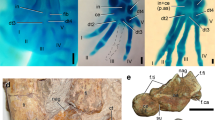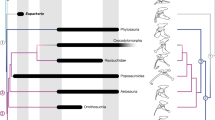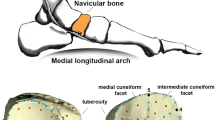Abstract
Several attempts have been made to outline the early evolution and radiation of the archosaurs through a study of the morphology and function of their ankle joints1–6 (Figs 1a, 2). Here we present new interpretations of the evidence which show that several aspects of archosaur ankle anatomy have been misunderstood, and we re-state the case for the ‘advanced mesotarsal’ (AM) ankle of the dinosaurs being derived from an intermediate stage and not directly from the ‘primitive mesotarsal’ ankle of a proterosuchid thecodontian (Fig. 1b). Two modifications to the original scheme2 are required. First, that Euparkeria-like ankles are basically ‘proterosuchian’, digitigrade and unlikely to be ancestral to any other form; the term ‘modified primitive mesotarsal’ is proposed to describe this pattern of ankle. The second modification is to recognize that no ‘advanced mesotarsal (reversed)’ ankle2 has been described to date, and that previous allocations of forms to this type have been in error. Therefore, all forms with the AM ankle (Fig. 2) probably share a common ancestry. The ‘advanced mesotarsal (normal)’ ankle seems to be present in all known dinosaurs. The ‘crocodile reversed’ ankle is at present known only in the Ornithosuchidae2. This supports earlier suggestions that the dinosaurs are a monophyletic group7–9, a view not generally accepted5. The character state used here to define the dinosaurs is acquisition of the ‘fully improved’ gait, exemplified by the AM ankle10.
This is a preview of subscription content, access via your institution
Access options
Subscribe to this journal
Receive 51 print issues and online access
$199.00 per year
only $3.90 per issue
Buy this article
- Purchase on Springer Link
- Instant access to full article PDF
Prices may be subject to local taxes which are calculated during checkout
Similar content being viewed by others
References
Cruickshank, A. R. I. S. Afr. J. Sci. 72, 37 (1976).
Cruickshank, A. R. I. S. Afr. J. Sci. 75, 168–178 (1979).
Thulborn, R. A. Alcheringa 4, 241–261 (1980).
Brinkman, D. Breviora 464, 1–23 (1981).
Chatterjee, S. Nature 295, 317–320 (1982).
Parrish, J. J. in 3rd Symp. Mesozoic Terrestrial Ecosystems, Short Papers (eds Reif, W. E. & Westphal, F.) 169–173 (Attempto, Tubingen, 1984).
Padian, K. Proc. 3rd N. Am. paleont. Conv. Vol. 2, 387–393 (1982).
Bakker, R. T. & Galton, P. M. Nature 249, 168–172 (1973).
Benton, M. J. in 3rd Symp. Mesozoic Terrestrial Ecosystems, Short Papers (eds Reif, W. E. & Westphal, F.) 13–18 (Attempto, Tubingen, 1984).
Charig, A. J. Symp. zool. Soc. Lond. 52, 597–628 (1984).
Chatterjee, S. Palaentology 21, 83–127 (1978).
Charig, A. J. in Studies in Vertebrate Evolution (eds Joysey, K. A. & Kemp, T. S.) 121–155 (Oliver & Boyd, Edinburgh, 1972).
Cooper, M. R. S. Afr. J. Sci. 77, 308–309 (1981).
Cruickshank, A. R. I. S. Afr. J. Sci. 77, 307–308 (1981).
Ewer, R. F. Phil. Trans. R. Soc. B248, 379–435 (1965).
Bonaparte, J. F. Op. lilloana 22, 1–183 (1972).
Cruickshank, A. R. I. Palaeont. afr. 18, 133–135 (1975).
Romer, A. S. Breviora 385, 1–21 (1972).
Cruickshank, A. R. I. Zool. J. Linn. Soc. 62, 161–177 (1978).
Madsen, J. H. Bull. Utah geol. miner. Surv. 109, 1–163 (1976).
Author information
Authors and Affiliations
Rights and permissions
About this article
Cite this article
Cruickshank, A., Benton, M. Archosaur ankles and the relationships of the thecodontian and dinosaurian reptiles. Nature 317, 715–717 (1985). https://doi.org/10.1038/317715a0
Received:
Accepted:
Issue Date:
DOI: https://doi.org/10.1038/317715a0
This article is cited by
-
3D hindlimb joint mobility of the stem-archosaur Euparkeria capensis with implications for postural evolution within Archosauria
Scientific Reports (2020)
-
Bird embryos uncover homology and evolution of the dinosaur ankle
Nature Communications (2015)
-
Ontogeny of the syndesmosis tibiofibularis and the evolution of the bird hindlimb: a caenogenetic feature triggers phenotypic novelty
Anatomy and Embryology (1989)
-
Joints of the crocodile-reversed archosaurs
Nature (1988)
-
Joints of the crocodile-reversed archosaurs
Nature (1988)
Comments
By submitting a comment you agree to abide by our Terms and Community Guidelines. If you find something abusive or that does not comply with our terms or guidelines please flag it as inappropriate.



